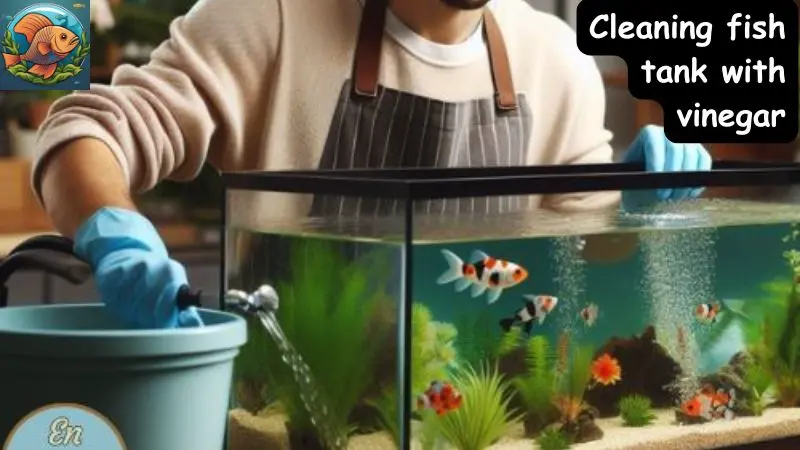fish farming
Cleaning fish tank with vinegar
The vibrant world within a fish tank, teeming with life and color, is a captivating sight. But maintaining this miniature ecosystem requires careful attention and regular cleaning. While traditional methods often involve harsh chemicals, a natural and effective alternative is using vinegar. This essay of fishtankmagic.com will delve into the benefits and proper techniques of cleaning your fish tank with vinegar, addressing safety concerns and offering a comprehensive guide to this eco-friendly approach.
The Power of Vinegar: A Natural Cleaning Agent
Vinegar, a household staple, is a potent cleaning agent with a wide range of applications. Its acidic nature effectively breaks down grime, mineral deposits, and algae, making it an ideal choice for cleaning fish tanks. The acetic acid in vinegar acts as a natural disinfectant, killing harmful bacteria and pathogens that can accumulate in the tank environment.
Benefits of cleaning fish tank with vinegar:
- Natural and Eco-Friendly: Vinegar is a biodegradable and non-toxic substance, making it a safer alternative to harsh chemical cleaners that can harm fish and disrupt the delicate tank ecosystem.
- Effective against Algae: Vinegar’s acidic properties effectively dissolve algae, preventing unsightly growth and maintaining a clear, pristine tank.
- Removes Mineral Deposits: Hard water can leave behind mineral deposits on tank surfaces, affecting water quality and aesthetics. Vinegar’s ability to dissolve these deposits ensures a clean and healthy environment for your fish.
- Cost-Effective: Vinegar is readily available and affordable, making it a budget-friendly option for maintaining your fish tank.
Understanding the Risks and Precautions
While vinegar offers a safe and effective cleaning method, it’s crucial to use it responsibly to avoid harming your fish. The key lies in dilution and proper application.
Potential Risks:
- High Acidity: Vinegar’s acidity, while beneficial for cleaning, can be harmful to fish if used undiluted or in excessive amounts.
- pH Imbalance: Introducing vinegar into the tank can temporarily alter the water’s pH level, potentially stressing your fish.
- Negative Impact on Beneficial Bacteria: Vinegar can kill beneficial bacteria that play a crucial role in the nitrogen cycle, which is essential for maintaining water quality.
Essential Precautions:
- Dilution: Always dilute vinegar with water before using it in the tank. A general rule of thumb is to use a 1:10 ratio of vinegar to water.
- Test the Water: Before adding vinegar to the tank, test the water’s pH level. Adjust the vinegar concentration accordingly to ensure a gradual and safe pH change.
- Partial Water Changes: Avoid using vinegar for full water changes. Instead, use it for spot cleaning and partial water changes.
- Observe Fish Behavior: Monitor your fish closely after using vinegar to ensure they are not exhibiting any signs of stress or distress.
Step-by-Step Guide to Cleaning Your Fish Tank with Vinegar
Materials:
- White vinegar
- Spray bottle
- Sponge or cloth
- Bucket
- Fish tank dechlorinator (optional)
Procedure:
- Prepare the Tank: Remove all fish, decorations, and plants from the tank. Place them in a separate container filled with tank water to prevent stress and maintain their environment.
- Dilute the Vinegar: Mix equal parts vinegar and water in a spray bottle.
- Clean the Tank: Spray the diluted vinegar solution onto the tank walls, glass, and any other surfaces that need cleaning. Use a sponge or cloth to scrub away algae, grime, and mineral deposits.
- Rinse Thoroughly: Rinse the tank thoroughly with clean water to remove all traces of vinegar.
- Clean Decorations and Plants: Clean decorations and plants separately using the diluted vinegar solution. Rinse them thoroughly with clean water before returning them to the tank.
- Dechlorinate the Water: If using tap water, add a dechlorinator to remove chlorine and chloramines before adding it to the tank.
- Refill the Tank: Fill the tank with fresh, dechlorinated water.
- Return Fish: Gradually return the fish to the tank, ensuring they acclimate to the new water conditions.
Maintaining a Clean and Healthy Tank with Vinegar
Regular cleaning is crucial for maintaining a healthy fish tank environment. Vinegar can be used for weekly spot cleaning and partial water changes. Here are some additional tips for using vinegar effectively:
- Target Specific Areas: Focus on areas with heavy algae growth, mineral deposits, or visible grime.
- Avoid Over-Cleaning: Excessive cleaning can disrupt the beneficial bacteria in the tank.
- Monitor Water Parameters: Regularly test the water’s pH, ammonia, nitrite, and nitrate levels to ensure they are within safe ranges.
- Use Vinegar Sparingly: Use vinegar only when necessary and avoid using it on a regular basis.
- Consider Alternative Cleaning Methods: For stubborn algae or mineral deposits, consider using a specialized algae scraper or a water-based cleaner formulated for fish tanks.
Conclusion: A Natural Approach to Fish Tank Maintenance
Cleaning your fish tank with vinegar offers a natural, effective, and affordable approach to maintaining a healthy and vibrant aquatic environment. By following the guidelines and precautions outlined in this essay, you can safely and effectively use vinegar to remove algae, mineral deposits, and grime, ensuring a clean and healthy home for your fish. Remember, responsible use and regular monitoring are key to achieving a thriving fish tank ecosystem.












